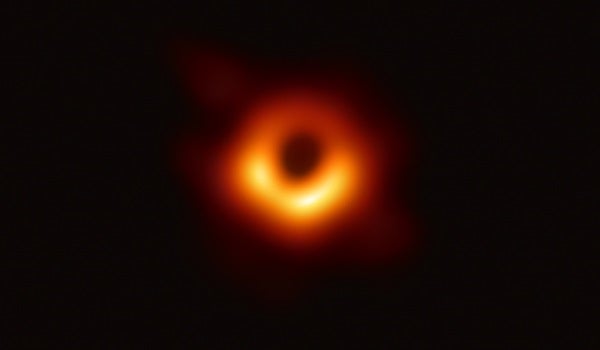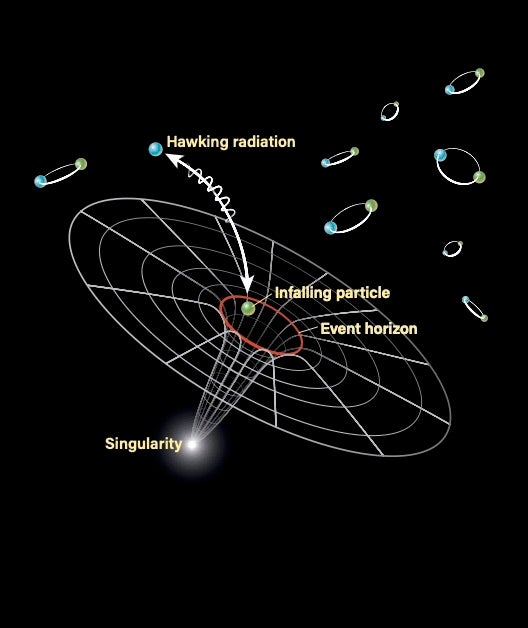Black holes are regions of space-time where gravity rules: The gravitational pull of a black hole is so strong that nothing, not even light, can escape. They range in size from stellar-mass black holes, whose masses can run from five to 100 times that of the Sun, all the way to supermassive black holes, which can reach well over a billion solar masses. Astronomers now believe supermassive black holes hide within the heart of most galaxies. (A notable exception to this rule is M33, which, despite being the third largest member of our Local Group, appears to lack a central supermassive black hole.)
Right now, the universe is in its Stelliferous Era, when stars and galaxies are continuously being born. Eventually, the ingredients to make these objects will be used up, and the stars in the night sky slowly will wink out, leaving black holes as the universe’s only occupants.
But even the black holes will one day die. And when they do, these monsters won’t go gently into the night. A burst of fireworks will light up the universe in the final moments of each black hole, heralding the end of the era.
Cheating death
Black holes survive by gobbling down the gas and stars around them, and it’s their gluttony that gives them away. They are often surrounded by accretion disks of material they’ve torn apart and sucked close, like water swirling down a drain. As material draws closer, it begins to travel faster and faster, piling up around the black hole. Friction among the dust generates heat, causing the accretion disk to glow, which outlines the shadow of the black hole — or its event horizon. “It wants to hide but it does a pretty bad job of it sometimes,” says Sheperd Doeleman, a black hole researcher at Harvard University and director of the Event Horizon Telescope, which snapped the first photo of a black hole in 2019.
Besides giving a black hole away, the event horizon is also the key to a black hole’s death.
The material that crosses a black hole’s horizon is lost forever, as nothing can escape the grip of these gluttonous monsters. At least, that’s what our current understanding of gravity dictates. But this so-called point of no return fails to take quantum mechanics into account. (Physicists are still working to develop a unified theory of quantum gravity.) In 1974, Stephen Hawking proved that, from a quantum perspective, escape from a black hole is possible, though it is very slow.
While empty space may seem devoid of energy, it isn’t — according to quantum mechanics, the energy of a vacuum fluctuates slightly over time. Those fluctuations manifest as pairs of particles — a particle and an antiparticle — that pop into and out of existence throughout the universe. Because energy cannot be created from nothing, one of the particles will have positive energy and the other negative. These particle pairs usually immediately annihilate one another. But if the particles appear at the boundary of a black hole’s event horizon, it’s possible for the particle with negative energy to fall into the black hole, while the particle with positive energy escapes. It then appears that the black hole has radiated a particle away. Einstein showed that energy and mass are proportional with his equation E = mc2. Therefore, the negative energy from the forsaken particle actually removes mass from the black hole, causing it to shrink.
But don’t expect a black hole to disappear any time soon. It takes a shockingly long time for a black hole to shed all of its mass as energy via Hawking radiation. It would take 10100 years, or a googol, for a supermassive black hole to fully disappear. “The entire age of the universe [is] a fraction of [the time] it would take,” says Priyamvada Natarajan, a researcher at Yale University who probes the nature of black holes. “As far as we’re concerned, it is eternity.”
Death throes
Exactly how long an individual black hole lives depends strongly on its mass. The larger a black hole gets, the longer it takes to evaporate. “In that sense, [a black hole] can cheat death by growing,” Doeleman says.
He compares the process to an hourglass, where the sand at the top is the amount of time a black hole has left. By gobbling down more stars and gas, a black hole continues to add sand to the hourglass of its life, even as individual particles trickle out. “As long as there is material around [to eat], the black hole can keep resetting its clock,” Doeleman says. Eventually, as the universe ages, the material around a black hole will run out and its doomsday clock will start ticking.
As a black hole evaporates, it slowly shrinks and, as it loses mass, the rate of particles escaping also increases until all the remaining energy escapes at once. In the final tenth of a second of a black hole’s life, “you will have a huge flash of light and energy,” Natarajan says. “It’s almost like a million nuclear fusion bombs going off in a very tiny region of space.”
By Earth’s standards, that’s a lot, significantly more than the total nuclear arsenal of all nations. In astronomical terms, not so much. The most powerful supernova yet recorded (ASSASN-15lh) was 22 trillion times more explosive than a black hole will be in its final moments.
It doesn’t matter how small or how massive a black hole is, their closing fireworks are exactly the same. The only difference is how long it will take a black hole to explode. But once a black hole gobbles down its last meal, all that’s left is for the sand grains to relentlessly tumble down until there’s nothing left.
This story comes from our special January 2021 issue, “The Beginning and the End of the Universe.” Click here to purchase the full issue.













